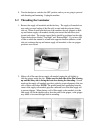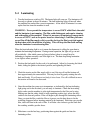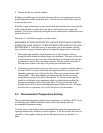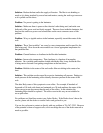6. Examine the film as it exits the machine.
If bubbles or wrinkles appear in the film, this means there is not enough tension to draw
the film tight and smooth over the heat shoes. Turn the tension control knobs clockwise
to increase the tension.
If the film is tight and smooth as it goes over the heat shoes but then draws in towards the
center of the machine or squeals, there may be too much tension on the supply roll
mandrels. This can be corrected by turning the tension control knobs counterclockwise to
decrease the tension.
Film that is 1.5-mil thickness requires very little tension.
REMEMBER TO TURN BOTH THE TOP AND BOTTOM TENSION CONTROL
KNOBS THE SAME AMOUNT TO KEEP TENSION THE SAME ON TOP AND
BOTTOM ROLLS. If the film curls up or down after it leaves the machine, read the
above section on supply roll tension again and readjust the supply tension on both rolls.
7. When starting the machine to begin lamination, let at least 10 inches of film go
through the rollers before inserting the items to be laminated. This takes out the slack
in the film and removes the cooler strip of film that forms just in front of the nip when
the laminator is hot but film is not being advanced. This also removes any areas of
film with excess adhesive that may have pooled just beneath the shoes.
8. If the tension appears balanced, but you notice waves or ripples toward the center of
the web of film as it comes out the back, the temperature may be too high or the
lamination speed may be too high for that film. These waves in the film are called
“heat wrinkles”. These heat wrinkles are formed when the film has not cooled
enough before coming out the back of the machine. For the best results, the film
should be cooled below melt temperature while it is pulled tight and perfectly flat
between the laminating rollers and the pull rollers. If it gets out the back of the
machine while still at or above melt temperature, heat wrinkles can form. The major
reason for fans on a laminator is to cool the film, not to cool the machine.
5-5 Recommended Temperature Settings
The recommended temperature setting for low-temperature 1.5-mil film is 240°F. If you
are laminating with a different thickness of film, refer to the following table for
recommended temperature settings.
Your first source of information about recommended film application temperatures and
operating characteristics should be your film suppliers. If you do not know the source of
your film, or if the supplier cannot provide the information, please use the table as a
guide.


















